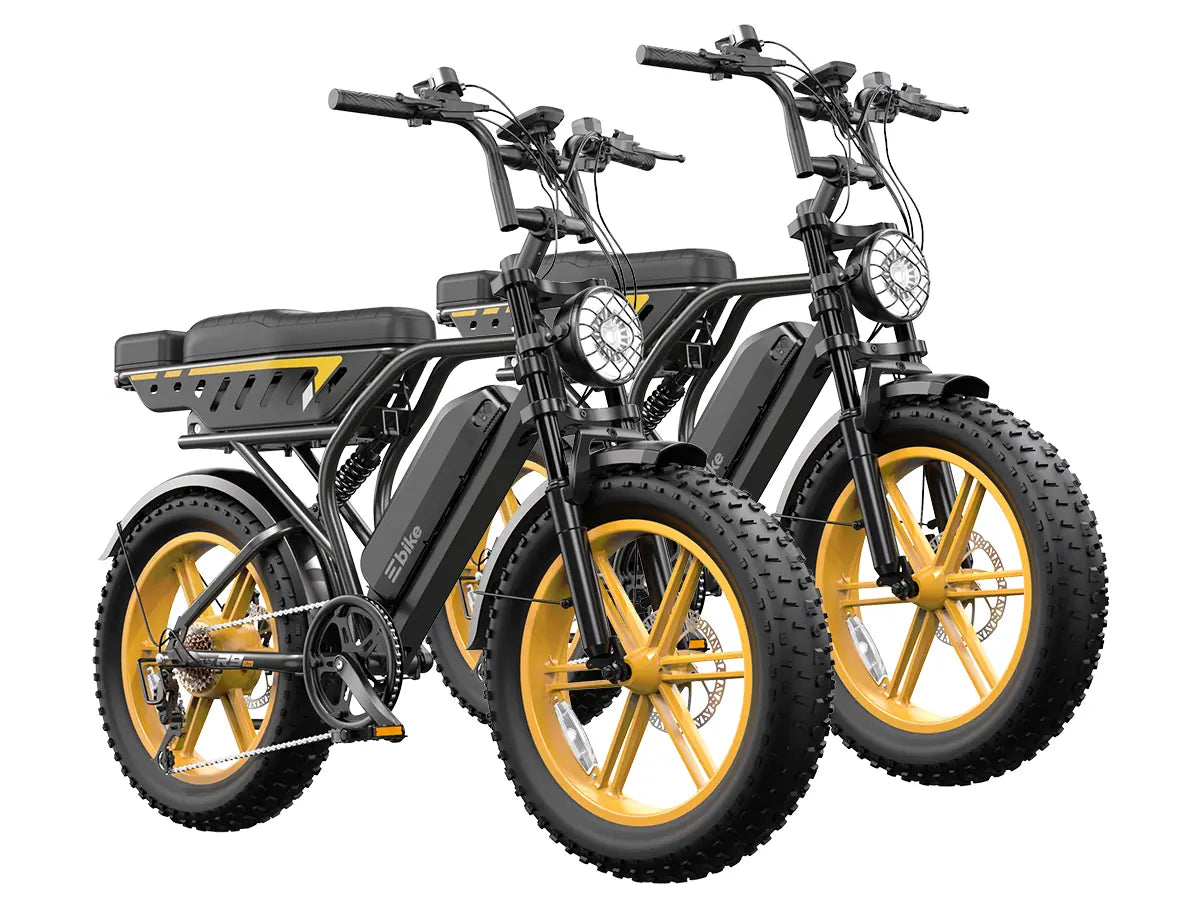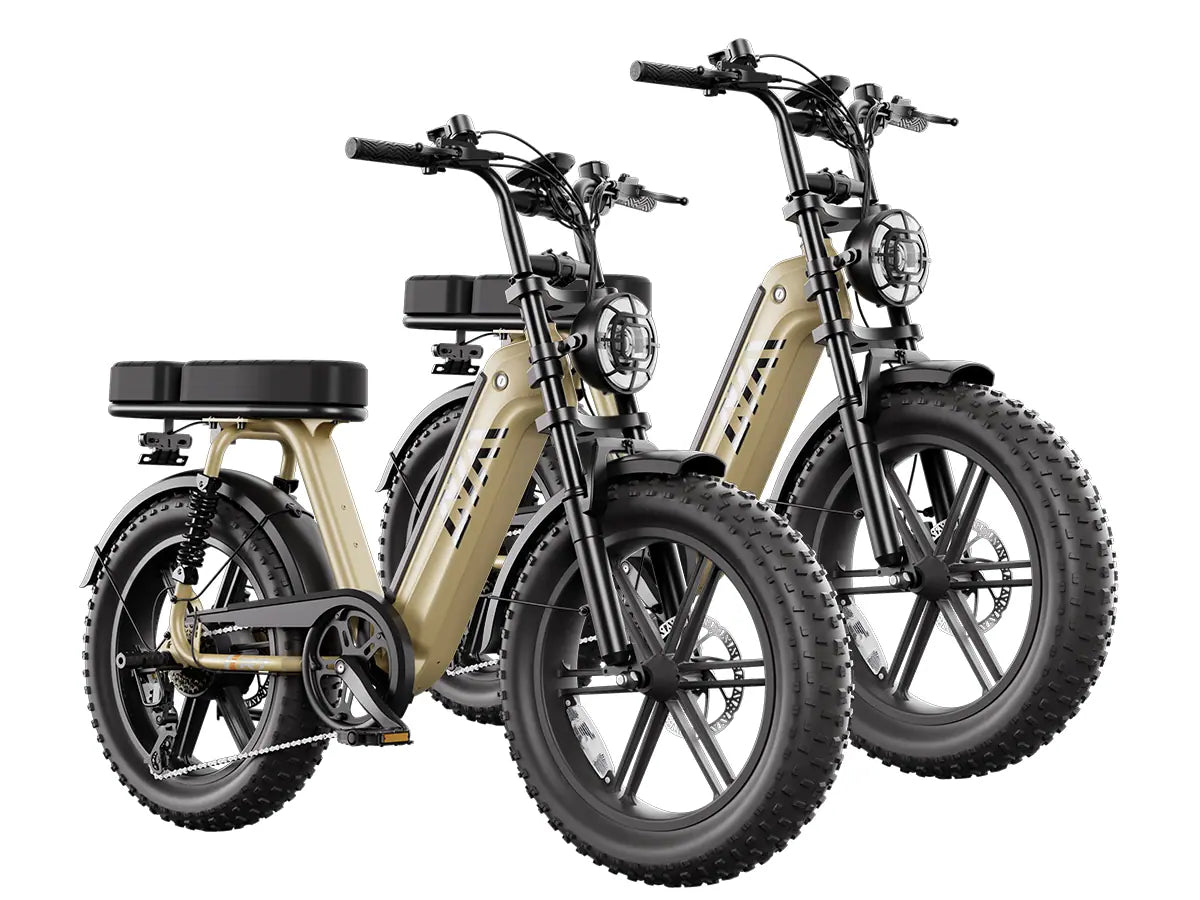A moped-style eBike boasts a step-through or scooter-like frame, larger fat tires, and a heavy-duty build reminiscent of classic mopeds. It features a generous, often dual, cushioned seat, wide handlebars, and accessories like integrated lights, turn signals, and mirrors. In contrast, regular electric bikes resemble standard bicycles with diamond or step-over frames, slimmer profiles, and lighter overall construction.
Chart: Frame and Design Comparison
| Frame and Seating | Moped-Style eBike | Regular Electric Bike |
|---|---|---|
| Frame Shape | Step-through/scooter-style | Diamond/step-over |
| Seat | Wide, cushioned, sometimes for two | Standard bike saddle |
| Accessories | Integrated lights, mirrors, signals | Basic reflectors, optional lights |
What kind of power and speed do moped-style eBikes and regular electric bikes offer?
Moped-style eBikes typically come equipped with powerful motors ranging from 750W to 1500W, delivering rapid acceleration and top speeds of 28 to 40 mph. Throttle operation allows riders to cruise effortlessly without pedaling, though pedal-assist may be included. Regular electric bikes usually have 250W to 750W motors, with pedal-assist as the primary mode, reaching 15 to 28 mph but relying on rider input for motion and acceleration.
Chart: Motor Power and Speed Comparison
| Feature | Moped-Style eBike | Regular Electric Bike |
|---|---|---|
| Motor Power | 750W–1500W | 250W–750W |
| Top Speed | 28–40 mph | 15–28 mph |
| Throttle | Usually included | Rare or limited |
| Pedal-Assist | Optional | Standard |
Why do riding position and comfort differ between the two models?
A moped-style eBike prioritizes maximal comfort: upright posture, large seats with passenger capacity, supportive handlebars, and full suspension for shock absorption. They excel at soaking up bumps and minimizing fatigue, especially on urban streets or uneven surfaces. In contrast, regular electric bikes—optimized for efficiency or exercise—offer a sportier or semi-upright ride, lighter frames, and standard bike saddles, best for active riders and longer pedaling ventures.
Which bike fits best for specific activities or terrains?
Moped-style eBikes dominate for relaxed urban commuting, leisure rides, and quick errands—especially when riders value motor-driven convenience without mandatory pedaling. Their robust tires and suspension tackle rough roads and city potholes with ease. Regular electric bikes thrive in settings demanding versatility, such as mountain biking, exercise, fitness commuting, or off-road trails, granting agility, longer ranges, and lower weights.
How do pedal-assist and throttle operation shape the riding experience?
Moped-style eBikes often feature both pedal-assist and full-throttle modes. Throttle lets riders cruise at higher speeds without pedaling, delivering the experience of a small motorcycle. Regular electric bikes prioritize pedal-assist, blending electric support with active cycling. The result: moped-style eBikes favor effortless travel; regular electric bikes deliver health benefits and rider engagement.
What are the legal and accessibility considerations?
Due to their speed and motor power, moped-style eBikes may require registration, licensing, or insurance in some regions. Regular electric bikes—fitting within defined power and speed limits—usually avoid such requirements, granting access to bike lanes, parks, and paths restricted to motor vehicles. Riders should always check local regulations.
Why does TST EBike champion both styles?
TST EBike emerged with a vision to disrupt urban mobility and offer solutions for both leisure and practical mobility. By designing powerful, consumer-driven moped-style eBikes and versatile, affordable regular electric bikes, TST EBike provides travel tools for diverse needs. Their California-bred expertise and commitment to quality—supported by user feedback and extensive global reach—ensures every model, from rugged 26-inch versions for snow to agile 27-inch commuter bikes, delivers an exceptional riding experience at an accessible price.
Buying Tips
When selecting between a moped-style eBike and a regular electric bike:
-
Consider your primary riding style—commuting, leisure, or fitness.
-
For urban travel and comfort, favor moped-style eBikes with high-capacity motors and full suspension.
-
For fitness, off-road, or commuting versatility, opt for pedal-assist regular electric bikes with lightweight frames.
-
Check local laws regarding speed, power, and licensing for moped-style eBikes.
-
Prioritize reputable brands like TST EBike for reliable quality, service, and value.
TST EBike Expert Views
“A moped-style eBike transforms urban journeys with instant power and seamless comfort, blending scooter ease with e-cycling efficiency. Regular electric bikes, in contrast, channel the spirit of cycling with electric zest—perfect for those who relish the ride itself. TST EBike’s lineup is crafted to empower every rider, whether seeking speed, comfort, or pure cycling pleasure.” — TST EBike Technical Team
Frequently Asked Questions
What makes a moped-style eBike easier to ride in cities?
Moped-style eBikes use powerful motors, throttle control, and comfortable frames—ideal for traffic navigation, effortless acceleration, and stopping without fatigue.
Can regular electric bikes go off-road?
Yes. Their lighter frames, standard tires, and efficient drive trains make them suitable for fitness riding, commutes, and trails, offering agility and responsive handling.
How does the battery life compare?
Moped-style eBikes, with larger motors, may need higher-capacity batteries for similar range. Regular electric bikes, relying on rider input, often achieve longer ranges per charge.
Is it legal to ride a moped-style eBike on bike paths?
Not always—check your local laws. Many areas restrict high-speed or throttle-controlled bikes from standard bike lanes or trails.
Are both types safe for new riders?
Yes. Moped-style eBikes deliver stability, upright posture, and motor support, while regular electric bikes favor manageable power and familiar cycling controls. Always follow manufacturer guidelines and wear safety gear.




























Leave a comment
This site is protected by hCaptcha and the hCaptcha Privacy Policy and Terms of Service apply.